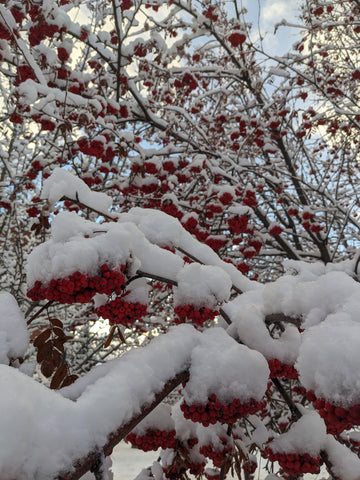Recettes de cueillette hivernale
Lorsque la neige arrive, la plupart des cueilleurs font une pause. Mais devinez quoi ? Même pendant les mois d'hiver, il existe de délicieuses plantes qui n'attendent qu'à être découvertes et récoltées. J'ai rassemblé une poignée de recettes et d'idées pour raviver votre connexion avec la nature à la période de l'année où il est le plus difficile de se sentir connecté. Rejoignez-moi pour célébrer la joie de cuisiner et de siroter des ingrédients trouvés dans les forêts ou les pelouses de votre voisinage. Gardons ce lien avec la nature vivant toute l'année.
Thé au cèdre

Dans le nord-ouest de l'Ontario et dans une grande partie du Canada, les cèdres sont très répandus. Le cèdre blanc de l'Est est utilisé traditionnellement comme médicament et lors de cérémonies depuis des milliers d'années, et il est toujours utilisé par les communautés autochtones de cette région. Ce thé a une saveur agréablement sucrée et terreuse, et regorge de vitamine C.
Coupez 4 à 6 grosses branches de cèdre blanc de l'Est (coupez les nouvelles pousses à partir des extrémités et n'en prenez pas plus que nécessaire). Portez une casserole moyenne d'eau à ébullition et ajoutez votre cèdre par-dessus. Laissez bouillir pendant 10 minutes ou jusqu'à ce que l'eau soit légèrement verte, puis retirez du feu. Nous vous recommandons d'ajouter une touche de miel.
Remarque importante : il ne s'agit pas d'une boisson quotidienne. Ne pas en consommer plus d'environ 1 tasse par semaine en raison de la présence d'un composé appelé thuyone, qui peut être toxique en grande quantité.

Gelée de baies de sorbier ou de sorbier

Ces fruits doivent être cuits avant d'être consommés pour être sûrs - ne les consommez pas crus. L'espèce européenne de sorbier ( Sorbus aucuparia ) est commune dans les villes et villages comme plantation ornementale, et le frêne américain ( Sorbus americana ) peut être trouvé dans certaines lisières de bois et sur les coteaux rocheux. Les baies ont une certaine amertume mais peuvent faire une excellente confiture ou gelée. Assurez-vous d'en laisser un peu pour les oiseaux !
Pour faire une gelée :
Ajoutez 4 tasses de baies de sorbier lavées et 2 tasses de pommes dans une casserole. Ajoutez juste assez d'eau pour couvrir les fruits et ajoutez éventuellement un brin de romarin frais.
Laissez mijoter pendant 20 minutes. Retirez du feu et écrasez les fruits avec un presse-purée, puis passez-les au tamis fin ou à l'aide de collants en nylon propres.
Pour chaque tasse de jus, ajoutez 1/2 tasse de sucre et faites bouillir pendant 10 à 15 minutes. Versez dans des bocaux propres et fermez hermétiquement.
Sumac vinaigrier

Les gousses de cette plante ont une saveur citronnée unique. Si vous les récoltez pour les utiliser comme épice, la plupart des gens suggèrent de les récolter fin août ou septembre, peu après la maturation des gousses, car une grande partie de leur saveur est emportée par la pluie et le temps. Cependant, vous pouvez toujours récolter le sumac en hiver si vous pouvez trouver des gousses de graines encore en bon état.
Pour préparer un délicieux thé glacé au citron, faites infuser 3 ou 4 grappes de baies dans de l'eau pendant environ 8 heures, mais évitez l'eau chaude ou bouillante car cela peut donner un goût amer et désagréable. Filtrez ensuite à travers une étamine ou une passoire très fine pour retirer les poils et les graines, puis sucrez avec du miel. C'est une plante courante au bord des routes, vous n'aurez probablement pas besoin de chercher bien loin ou de vous frayer un chemin pour la trouver. Les gousses de graines rouge vif sortent du haut des branches et pointent généralement vers le ciel.
Thé à l'églantier

Saviez-vous que les cynorhodons contiennent des concentrations d’antioxydants encore plus élevées que les myrtilles, les cassis, les baies d’aubépine ou les baies de sorbier ?
Si vous avez l'intention d'utiliser les cynorhodons pour les consommer dans une confiture ou une recette alimentaire, vous devrez retirer les graines et les poils à l'intérieur car ils peuvent irriter votre gorge et votre tube digestif s'ils sont laissés à l'intérieur. Cependant, pour le thé, vous pouvez les laisser entiers et sauter cette étape.
Séchez les cynorhodons en les étalant à plat sur une plaque de cuisson et en les plaçant dans votre four à la température la plus basse possible. Laissez-les sécher pendant plusieurs heures, jusqu'à ce qu'ils soient complètement secs et cassants. Vous pouvez ensuite les conserver dans un bocal hermétique et les ajouter aux thés pour ajouter des vitamines et des antioxydants. Ils se marient bien avec l'hibiscus, la framboise, l'anis et de nombreux autres ingrédients de tisanes si vous souhaitez les mélanger à d'autres saveurs.
Soda aux aiguilles de pin
Faites fermenter votre propre soda au pin si vous n’avez pas encore essayé cette recette !
Notes sur la recherche de nourriture
La cueillette responsable implique des recherches approfondies, une identification précise des plantes, des méthodes de récolte éthiques et une connaissance des risques avant de récolter ou de consommer des plantes sauvages.
